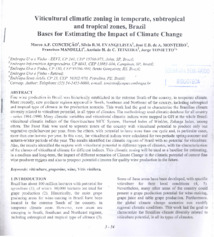Viticultural climatic zoning in temperate, subtropical and tropical zones, Brazil: bases for estimating the impact of climate change.
Viticultural climatic zoning in temperate, subtropical and tropical zones, Brazil: bases for estimating the impact of climate change.
Author(s): CONCEIÇÃO, M. A. F.; EVANGELISTA, S. R. M.; MONTEIRO, J. E. B. de A.; MANDELLI, F.; TEIXEIRA, A. H. de C.; TONIETTO, J.
Summary: Fine wine production in Brazil was historically established in the extreme South of the country, in temperate climate. More recently, new producer regions appeared in South, Southeast and Northeast of the country, including subtropical and tropical type of climate in the production scenario. This work had the goal to characterize the Brazilian climate diversity related to viticulture potential, in all types of climates. The methodology used climatic database for all country - series 1961-1990. Many climatic variables and viticultural climatic indices were mapped in GIS at the whole Brazil: viticultural climatic indices of the Geoviticulture MCC System, Thermal Index of Winkler, Zuluaga Index, among others. The Frost Risk was used to separate zones of the country with viticultural potential to produce only one vegetative cycle/harvest per year, from the others, with potential to have more than one cycle and, in particular cases, more than one harvest per year. In this case, the viticultural indices were calculated for two periods: spring-summer and autumn-winter periods of the year. The results identified the climatic regions of Brazil with no potential for viticulture. Also, the results identified the regions with viticultural potential in different types of climates, with the characterization of the classes of viticultural climate for different indices. This climatic zoning will be used as a baseline for estimating, in a medium and long-term, the impact of different scenarios of Climate Change in the climatic potential of current fine wine producer regions and also to prospect potential climates for quality wine production in the future.
Publication year: 2012
Types of publication: Paper in annals and proceedings
Unit: Embrapa Semi-arid Region
Observation
Some of Embrapa's publications are published as ePub files. To read them, use or download one of the following free software options to your computer or mobile device. Android: Google Play Books; IOS: iBooks; Windows and Linux: Calibre.
Access other publications
Access the Agricultural Research Database (BDPA) to consult Embrapa's full library collection and records.
Visit Embrapa Bookstore to purchase books and other publications sold by Embrapa.

